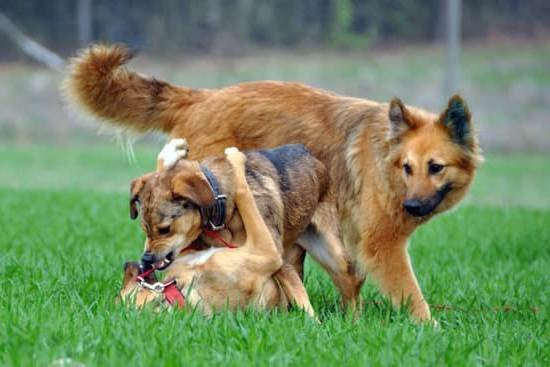Does crate training stop dogs biting? Many dog owners have pondered this question when dealing with their pet’s biting behavior. Crate training is a widely used method for addressing various behavioral issues in dogs, including biting.
By providing a secure and comfortable space for dogs, crate training can play a significant role in modifying their behavior. This article aims to explore the effectiveness of crate training in stopping dogs from biting and how it can be implemented as a solution.
Understanding the reasons behind dog biting is crucial in addressing the issue effectively. Factors such as fear, aggression, teething, and lack of socialization can contribute to a dog’s tendency to bite. Crate training offers several benefits in addressing these underlying causes by providing a safe environment where dogs can feel secure and calm. By understanding the root causes of biting behavior, dog owners can utilize crate training as an effective tool for behavior modification.
In addition to providing a safe space for dogs, crate training also promotes positive habits and discipline. It helps in teaching bite inhibition and controlling impulsive behaviors, ultimately leading to a decrease in biting incidents. To fully comprehend the impact of crate training on bite inhibition, it is essential to delve into the process of how crate training works and its specific role in addressing biting behavior in dogs.
Understanding Dog Biting
When it comes to understanding why dogs bite, it is essential to consider the various factors that may contribute to this behavior. Fear is a common cause of biting in dogs, as they may feel threatened or anxious in certain situations. Understanding and addressing the source of their fear can be crucial in preventing biting incidents. Additionally, aggression can also lead to biting behavior, especially if a dog feels the need to defend itself or its territory.
Teething is another reason why puppies may exhibit biting behavior. Just like human babies, puppies go through a teething phase where they experience discomfort and tend to alleviate it by chewing and biting on objects – including hands and fingers. Proper training and providing appropriate chew toys can help redirect this behavior.
Furthermore, lack of socialization can also contribute to biting tendencies in dogs. Without proper exposure to various people, animals, and environments during their developmental stages, dogs may become fearful or insecure, leading to aggressive responses such as biting.
It is important for dog owners to be aware of these reasons for biting behavior in order to effectively address and manage them. By understanding the root causes of their dog’s behavior, owners can implement appropriate training techniques such as crate training to encourage positive habits and discourage biting tendencies. Here are some essential guidelines for crate training that can aid in addressing dog biting issues:
- Choose an appropriately sized crate that allows your dog to stand up, turn around comfortably and lie down.
- Associate the crate with positive experiences by providing treats or toys inside.
- Gradually increase the amount of time your dog spends in the crate while ensuring it remains a safe and comfortable space for them.
By implementing these strategies alongside understanding the reasons behind dog biting behavior, owners can make significant progress in curbing this issue through effective crate training methods.
Benefits of Crate Training
Crate training offers several benefits when it comes to addressing biting behavior in dogs. Utilizing a crate can provide a safe and secure environment for a dog, especially during moments of anxiety or excitement that may trigger biting. Some of the advantages of using crate training as a tool to address biting behavior in dogs include:
- Establishing a Safe Space: Crates can serve as a den-like space where dogs feel secure and comfortable, reducing the likelihood of anxious or aggressive behaviors such as biting.
- Managing Teething Issues: For puppies, crate training can help manage teething-related biting by providing them with appropriate chew toys and preventing them from nipping at people or furniture.
- Preventing Overstimulation: Crates can be used to limit overstimulation or exhaustion in dogs, which can sometimes lead to heightened aggression and biting tendencies.
By understanding the benefits of crate training in addressing biting behavior, dog owners can effectively leverage this method to promote positive behavioral changes in their pets.
In addition to providing a safe space for dogs and managing teething issues, crate training also plays a crucial role in establishing routine and promoting self-control. When used correctly, crates can become valuable tools in teaching bite inhibition and controlling impulses in dogs. Furthermore, crates offer a practical solution for managing a dog’s environment when they are unable to be supervised, preventing potential opportunities for biting incidents.
Ultimately, the advantages of using crate training as an approach to address biting behavior extend beyond behavioral modification. Through proper and consistent use of crates, dog owners have the opportunity to create a comfortable and structured living environment for their pets while addressing biting issues effectively.
How Crate Training Works
Crate training is a popular method used by dog owners to address a variety of behavioral issues, including biting. The process involves acclimating a dog to a crate or kennel as a safe and comfortable space, which can serve as their den or personal sanctuary. When it comes to addressing biting behavior in dogs, crate training can be an effective tool for several reasons.
One way in which crate training works to discourage biting behavior is by providing the dog with a designated place where they can go to relax and unwind. By creating a positive association with the crate through rewards and praise, dogs can learn to view it as a peaceful retreat rather than a punishment.
This can be particularly helpful when managing biting behavior, as the dog may instinctively seek out their crate when feeling overwhelmed or agitated, rather than resorting to aggressive behaviors.
Additionally, crate training allows for the implementation of structured routines and boundaries, which are essential for addressing biting issues in dogs. By establishing consistent feeding schedules, potty breaks, and playtime within the confines of the crate, owners can effectively manage their dog’s behavior and prevent opportunities for unwanted biting. Furthermore, using the crate as a temporary time-out space when the dog exhibits biting behavior can help them understand that such actions are not acceptable.
In essence, the process of crate training involves gradually introducing the dog to the crate, making it a comfortable and secure environment through positive reinforcement, and using it strategically to manage their behaviors. By leveraging these aspects of crate training, owners can work towards discouraging biting behavior in their dogs while promoting positive habits and behaviors.
Crate Training and Bite Inhibition
Crate training plays a significant role in teaching dogs bite inhibition and controlling their impulses to bite. Bite inhibition refers to the dog’s ability to control the force of its bite, making it an essential skill for any pet. Through crate training, owners can effectively address biting behavior and encourage their dogs to develop better self-control.
Understanding Bite Inhibition
Bite inhibition is crucial for dogs as it allows them to interact with humans and other animals without causing harm. It involves teaching a dog to use its mouth gently during play or when interacting with people, thereby reducing the risk of causing injury. Without proper bite inhibition training, a dog may inadvertently cause harm through overly aggressive biting behavior, especially during moments of excitement or fear.
Role of Crate Training in Bite Inhibition
Crate training provides a controlled environment where owners can actively work on teaching their dogs bite inhibition. By using the crate as a tool for managing the dog’s behavior, owners can set clear boundaries and establish routines that promote self-control. The crate serves as a safe space for the dog to retreat to when feeling overwhelmed, helping it learn how to manage its impulses and calm itself down without resorting to biting.
Building Self-Control Through Crate Training
Crate training also encourages dogs to develop better self-control by providing them with opportunities for quiet time and relaxation. By creating a positive association with the crate through rewards and comforting items, dogs learn to regulate their emotions and physical responses.
This process helps in shaping their behavior, including how they interact with others and control their urge to bite. As a result, crate training not only addresses biting behavior but also contributes to overall obedience and socialization skills in dogs.
Common Mistakes to Avoid
When it comes to crate training, it is important to be aware of potential pitfalls that could inadvertently worsen biting behavior in dogs if not handled properly. Avoiding these common mistakes can help ensure that crate training effectively addresses biting issues in dogs without causing additional problems.
Using the Crate as Punishment
One common mistake to avoid when crate training a dog is using the crate as a form of punishment. If a dog associates the crate with negative experiences, such as being isolated or reprimanded, it can lead to increased anxiety and stress, which may exacerbate biting behavior. The crate should be a safe and comfortable space for the dog, not a place of punishment or isolation.
Leaving the Dog in the Crate for Extended Periods
Another mistake to avoid is leaving the dog in the crate for extended periods of time. While crate training can be an effective tool for managing biting behavior, it should not be used as a substitute for proper exercise and socialization. Dogs need regular opportunities for physical activity, mental stimulation, and social interaction. Leaving a dog confined to a crate for too long can lead to pent-up energy and frustration, which may manifest as increased biting tendencies.
Not Providing Proper Chew Toys and Mental Stimulation
Inadequate provision of chew toys and mental stimulation can also hinder the success of crate training in addressing biting behavior. Dogs often resort to biting when they are bored or seeking oral stimulation. Providing appropriate chew toys and engaging activities can help redirect their focus and discourage inappropriate chewing or biting. Failure to provide these outlets while crating a dog can lead to an increase in unwanted chewing and biting behaviors.
Avoiding these common mistakes while crate training can help set the stage for successful behavioral modification in dogs with biting issues. By ensuring that the crate is used as a positive space, providing adequate exercise and mental stimulation outside of crating, and offering appropriate chew toys, pet owners can maximize the effectiveness of this training method in addressing biting behavior in their dogs.
Tips for Successful Crate Training
Crate training can be an effective method for addressing biting behavior in dogs. When used correctly, a crate can provide a safe and comfortable space for your dog while also helping to teach them appropriate behavior. One of the key benefits of crate training is that it gives your dog a designated area where they can feel secure and relaxed, which can help reduce stress and anxiety – both of which can be common triggers for biting behavior.
In addition, crate training can also aid in establishing a routine for your dog, which is essential for their overall well-being. By creating a predictable schedule that includes time spent in the crate for rest and relaxation, you can help your dog develop good habits and avoid situations that may lead to aggressive or biting behavior.
Furthermore, crate training can also be an effective tool for managing teething-related biting in puppies, as it provides them with a safe place to chew on appropriate toys and treats.
It’s important to note that while crate training offers numerous benefits for addressing biting behavior in dogs, it should always be done with care and consideration for your dog’s individual needs. Using the crate as a punishment or leaving your dog confined for long periods of time can have negative consequences and may even exacerbate biting behavior.
Therefore, it’s crucial to approach crate training with patience, positive reinforcement, and an understanding of your dog’s specific triggers and tendencies.
| Advantages of Crate Training | Benefits |
|---|---|
| Provides a safe and secure space | Reduces stress and anxiety |
| Establishes a routine | Aids in managing teething-related biting |
| Promotes good habits | Should be done with care and positive reinforcement |
Case Studies
Dogs biting can be a serious issue for pet owners, but crate training has been shown to be an effective tool in addressing this behavior. Case studies and success stories provide evidence of how crate training has helped to control and reduce biting behavior in dogs.
One case study involved a rescue dog with a history of aggression and biting. The dog was introduced to crate training as a way to provide a safe and secure environment, while also giving the dog an opportunity to learn impulse control and proper behavior.
Over time, the dog’s aggressive tendencies decreased, and the frequency of biting incidents significantly declined. As the dog became more accustomed to the routine of crate training, it learned to associate the crate with positive experiences, leading to a reduction in fear-based aggression.
In another case study, a young puppy exhibited nipping behavior that escalated into biting whenever it felt threatened or anxious. Through consistent crate training, the puppy learned bite inhibition and was able to manage its impulses more effectively. The crate provided a place for the puppy to retreat when feeling overwhelmed, reducing instances of nipping and biting.
| Case Study | Outcome |
|---|---|
| Rescue Dog | Decrease in aggressive tendencies; significant decline in biting incidents. |
| Young Puppy | Learned bite inhibition; reduced instances of nipping and biting. |
Conclusion
In conclusion, crate training has been shown to be an effective tool in addressing biting behavior in dogs. By providing a safe and comfortable space for dogs to retreat to, crate training can help address the underlying reasons for biting, such as fear, anxiety, or lack of socialization. Additionally, crate training can be used to teach bite inhibition and control a dog’s impulse to bite, ultimately reducing the likelihood of aggressive behavior.
While crate training is not a one-size-fits-all solution, it can be a valuable component of a comprehensive approach to addressing dog biting issues. It is important for pet owners to understand the reasons why their dog may be exhibiting biting behavior and to seek guidance from a professional trainer or behaviorist if needed. Additionally, crate training should always be implemented in a positive and compassionate manner, avoiding common mistakes that may inadvertently worsen the problem.
Overall, crate training has the potential to make a significant impact on reducing dog biting incidents when used correctly and in combination with other behavioral interventions. With patience, consistency, and proper guidance, pet owners can leverage the benefits of crate training to create a safe and harmonious environment for their canine companions.
Frequently Asked Questions
Should You Put Dog in Crate When Biting?
When a dog is biting, placing them in a crate can be an effective way to give them a time-out and prevent any further negative behavior. It’s important to make sure the crate is seen as a safe and comfortable space for the dog, rather than as a punishment.
How Do You Train a Dog to Stop Biting You?
Training a dog to stop biting involves several steps, including socialization, teaching bite inhibition, and providing appropriate chew toys. Consistent training methods such as yelping when bitten, redirecting their attention, and rewarding good behavior can help reinforce the message that biting is not acceptable.
How Do You Discipline a Puppy for Biting?
Discipline should be used carefully with puppies to avoid creating fear or anxiety. Instead of punishment, it’s better to use redirection and positive reinforcement when a puppy bites. This can involve offering chew toys, removing attention when they bite, and praising them when they display gentle behavior. Consistency and patience are key in effectively disciplining a puppy for biting.

Welcome to the blog! I am a professional dog trainer and have been working with dogs for many years. In this blog, I will be discussing various topics related to dog training, including tips, tricks, and advice. I hope you find this information helpful and informative. Thanks for reading!





